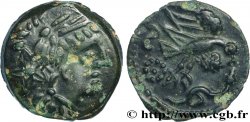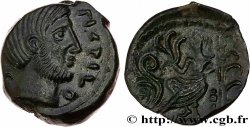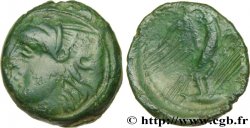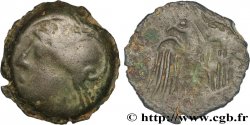v20_0200 - GALLIA - CARNUTES (Beauce area) Quart de statère d’or au loup (ou au sanglier) conducteur
MONNAIES 20 (2004)
Starting price : 450.00 €
Estimate : 1 000.00 €
Realised price : 476.00 €
Number of bids : 2
Maximum bid : 476.00 €
Starting price : 450.00 €
Estimate : 1 000.00 €
Realised price : 476.00 €
Number of bids : 2
Maximum bid : 476.00 €
Type : Quart de statère d’or au loup (ou au sanglier) conducteur
Date: Ier siècle avant J.-C.
Mint name / Town : Chartres (28)
Metal : gold
Diameter : 12,5 mm
Orientation dies : 1 h.
Weight : 1,90 g.
Rarity : R3
Coments on the condition:
Belle monnaie pour ce type rarissime, en très bon or. Le droit est mal frappé, avec une impression de coin rouillé. Le revers est complet et bien centré sur un flan large, mais avec une petite faiblesse de frappe en son centre
Obverse
Obverse legend : ANÉPIGRAPHE.
Obverse description : Tête imitée de Philippe II, à droite.
Reverse
Reverse legend : ANÉPIGRAPHE.
Reverse description : Cheval harnaché à droite, sanglier-aurige ou loup-aurige sur la croupe. Petit aigle aux ailes éployées entre les jambes du cheval, grènetis.
Commentary
Ce type de quart de statère semble n'être apparu que très récemment, puisqu'il manque à tous les musées consultés. Cette monnaie est excessivement rare et ne doit être connue qu'à moins d'une dizaine d'exemplaires. Ce type sera illustré dans le Nouvel Atlas tome II, de L.-P. Delestrée et M. Tache. Il est intéressant de noter que "l'animal aurige" tient les rênes du cheval avec les pattes arrières.








 Report a mistake
Report a mistake Print the page
Print the page Share my selection
Share my selection Ask a question
Ask a question Consign / sell
Consign / sell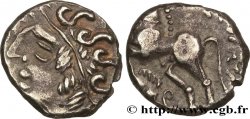
 Full data
Full data